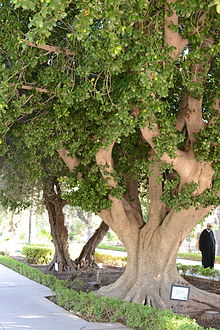Ficus retusa: Difference between revisions
Destroyeraa (talk | contribs) mNo edit summary |
Destroyeraa (talk | contribs) m :) |
||
| Line 27: | Line 27: | ||
''Ficus retusa'' is a rapidly growing, rounded, broad-headed, evergreen [[shrub]] or tree that can reach {{Convert|10|m|ft}} in height<ref>http://portal.cybertaxonomy.org/flora-malesiana/cdm_dataportal/taxon/23e41796-bd42-4f09-9d8e-7b81213beb5a</ref> with an equal spread. The smooth, light grey trunk is quite striking, can grow to around {{convert|1|m|ft}} in diameter, and it firmly supports the massively spreading canopy. |
''Ficus retusa'' is a rapidly growing, rounded, broad-headed, evergreen [[shrub]] or tree that can reach {{Convert|10|m|ft}} in height<ref>http://portal.cybertaxonomy.org/flora-malesiana/cdm_dataportal/taxon/23e41796-bd42-4f09-9d8e-7b81213beb5a</ref> with an equal spread. The smooth, light grey trunk is quite striking, can grow to around {{convert|1|m|ft}} in diameter, and it firmly supports the massively spreading canopy. |
||
The tree has glabrous obovate leaves, usually longer than {{convert|10|cm|in}} and spirally arranged. It has a gray to reddish bark dotted with small, horizontal flecks, called lenticels, that are used by woody plant species for supplementary gas exchange through the bark. The name is commonly used to refer to ornamental indoor plants (bonsai) widely cultivated in temperate regions, but such plants generally belong to another species, ''[[Ficus microcarpa]]''<ref name=":0" /><ref name=":1" /><ref>https://www.itis.gov/servlet/SingleRpt/SingleRpt?search_topic=TSN&search_value=513575#null</ref><ref>https://npgsweb.ars-grin.gov/gringlobal/taxonomydetail.aspx?id=408755</ref>. The two species can be distinguished from the length of the leaf blade (usually {{convert|10-20|cm|in}} for ''F. retusa'', and usually less than {{convert|10|cm|in}} for ''F. microcarpa'' but rarely up to {{convert|15|cm|in}}<ref>http://portal.cybertaxonomy.org/flora-malesiana/cdm_dataportal/polytomousKey/34e20c12-e562-41b4-ab5e-92df542cd6a2</ref>). |
The tree has glabrous obovate leaves, usually longer than {{convert|10|cm|in}} and spirally arranged. It has a gray to reddish bark dotted with small, horizontal flecks, called lenticels, that are used by woody plant species for supplementary gas exchange through the bark. The name is commonly used to refer to ornamental indoor plants (for example bonsai) widely cultivated in temperate regions, but such plants generally belong to another species, ''[[Ficus microcarpa]]''<ref name=":0" /><ref name=":1" /><ref>https://www.itis.gov/servlet/SingleRpt/SingleRpt?search_topic=TSN&search_value=513575#null</ref><ref>https://npgsweb.ars-grin.gov/gringlobal/taxonomydetail.aspx?id=408755</ref>. The two species can be distinguished from the length of the leaf blade (usually {{convert|10-20|cm|in}} for ''F. retusa'', and usually less than {{convert|10|cm|in}} for ''F. microcarpa'' but rarely up to {{convert|15|cm|in}}<ref>http://portal.cybertaxonomy.org/flora-malesiana/cdm_dataportal/polytomousKey/34e20c12-e562-41b4-ab5e-92df542cd6a2</ref>). |
||
==Notes== |
==Notes== |
||
Revision as of 20:01, 27 July 2020
| Ficus retusa | |
|---|---|

| |
| Free-standing Ficus retusa street tree | |
| Scientific classification | |
| Kingdom: | |
| (unranked): | |
| (unranked): | |
| (unranked): | |
| Order: | |
| Family: | |
| Genus: | |
| Species: | F. retusa
|
| Binomial name | |
| Ficus retusa | |
| Synonyms[1] | |
| |
Ficus retusa is a species of evergreen woody plant in the fig genus, native to the Malay Archipelago and Malesia floristic region. The species name has been widely mis-applied to Ficus microcarpa[2][3][4].
Description
Ficus retusa is a rapidly growing, rounded, broad-headed, evergreen shrub or tree that can reach 10 metres (33 ft) in height[5] with an equal spread. The smooth, light grey trunk is quite striking, can grow to around 1 metre (3.3 ft) in diameter, and it firmly supports the massively spreading canopy.
The tree has glabrous obovate leaves, usually longer than 10 centimetres (3.9 in) and spirally arranged. It has a gray to reddish bark dotted with small, horizontal flecks, called lenticels, that are used by woody plant species for supplementary gas exchange through the bark. The name is commonly used to refer to ornamental indoor plants (for example bonsai) widely cultivated in temperate regions, but such plants generally belong to another species, Ficus microcarpa[3][4][6][7]. The two species can be distinguished from the length of the leaf blade (usually 10–20 centimetres (3.9–7.9 in) for F. retusa, and usually less than 10 centimetres (3.9 in) for F. microcarpa but rarely up to 15 centimetres (5.9 in)[8]).
Notes
- ^ The Plant List: A Working List of All Plant Species, retrieved 13 April 2016
- ^ "Ficus microcarpa L. f.", USDA GRIN Taxonomy
- ^ a b Chaudhary, Lal; Sudhakar, Jana; Srivastava, Anoop; Bajpai, Omesh; Tiwari, Rinkey; V S Murthy, G (2012-01-19). "Synopsis of the Genus Ficus L. (Moraceae) in India". Taiwania. 57: 193–216. doi:10.6165/tai.2012.57(2).193.
- ^ a b "The Gardens' bulletin, Singapore". [ser.4]:v.17. 1947.
{{cite journal}}: Cite journal requires|journal=(help) - ^ http://portal.cybertaxonomy.org/flora-malesiana/cdm_dataportal/taxon/23e41796-bd42-4f09-9d8e-7b81213beb5a
- ^ https://www.itis.gov/servlet/SingleRpt/SingleRpt?search_topic=TSN&search_value=513575#null
- ^ https://npgsweb.ars-grin.gov/gringlobal/taxonomydetail.aspx?id=408755
- ^ http://portal.cybertaxonomy.org/flora-malesiana/cdm_dataportal/polytomousKey/34e20c12-e562-41b4-ab5e-92df542cd6a2
